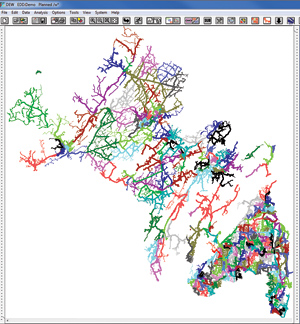As the scope of Smart Grid evolves, some are wondering what the role of GIS will be. GIS will define and maintain more accurate, complete network models and be an integral part of new Outage Management (OMS) and Advanced Distribution Management Systems (ADMS). GIS will provide the geographical organizational aspects of Business Intelligence (BI) and Data Analytics (DA) capabilities. Whether it is analysis of networks or display of Key Performance Indicators, the results will come from time-series simulations that much more nearly model real time network performance.
Smart Grid, Phase 2
As 2012 begins, Smart Grid (SG) projects are experiencing a change in intent, focus and funding. Most initial SG projects (i.e., those enabled by American Recovery & Reinvestment Act funding) are focused on Smart Meter (SM) implementation and improved energy utilization promoted by new rate and billing models. As these projects near full implementation, it is time to define and examine second stage SG objectives – commonly referred to as Smart Grid 2.0.
With ARRA urgency, many utilities rushed to deploy SM without understanding short interval meter data applications or contracting for systems designed to manage new network environments and massive data volumes. Many utilities also postponed SG initiatives that were not directly enabled by SM. The next phase of SM – SG 2.0 – will focus on:
- Completing SM installations
- Implementing Meter Data Management systems
- Supporting Energy Efficiency, Demand Response, Time-of-Use and other real-time pricing and Load Management requirements
- Improving outage identification, verification and restoration
- Implementing new, more accurate network models
- Supporting automated connect and disconnect
- Implementing new BI and DA applications that support massive amounts of SG data
- Improving energy delivery and network reliability with new equipment such as VAR Optimization, synchrophasors, and other monitoring and control devices
- Managing highly variable, distributed renewable generation
- Supporting plug-in electric hybrid and electrical vehicles
- Providing new levels of network control including SCADA, Distribution Energy Management, microgrids and other advanced controls
- Enhanced maintenance to reduce the impact of aging infrastructure and delayed maintenance
Like most SG projects today, the explicit requirements of SG 2.0 will vary from utility to utility.
Evolving from Static Models to Operational Simulations
As SG 2.0 evolves, network modeling will change as summarized below.
- Static analysis models based on specific configurations and seasonal loads will change to time-based simulation models. Full operational simulations will be available for analysis by dealing with time-series (i.e., what happens as generation sources, loads, and system configurations change over time) analyses.
- Model accuracy will greatly increase. Rather than static seasonal loads, operational simulations will use hourly loads. For the model, energy sources such as wind and solar will also vary with time to simulate the inherent variability of distributed renewable generation.
- Models will more closely depict ‘physics’ simulations rather than today’s typical static loads and generalized connectivity models. With a physics model, actual observations are simulated at any point in the network, allowing users to analyze complete network performance with graphs of voltage, loads and other parameters.
- Today there are many specialized specific purpose models with limited scope and model-specific network properties. With SG 2.0, these specialized models will be replaced by one integrated system model that starts at the source of energy (generation) and flows through a full three-phase model down to individual meters. Virtually every component, including loops, will be analyzed using specific physical component properties.

Utilities will define, monitor and control large, complex models
of all components from generation to meter such as this network
of 350,000 meters, providing a common model for design,
planning, operation and control. (Diagram Courtesy of
Electrical Distribution Design (EDD); Blacksburg, Virginia USA)
GIS and the New Integrated Network Connectivity Models
These new network models are the combination of four enhanced data sources:
- Topology or connectivity maintained by the GIS
- Enhanced engineering properties for each network component
- Enhanced individual customer loads modeled over time
- Real-time network measurements
Virtually all major GIS systems support complete radial distribution network architecture, but North American utilities don’t always capture all of the data supported by the architecture. For example, they may not:
- Capture secondaries, or data may be inaccurate or incomplete
- Use full three-phase models down to the meter
- Connect meters accurately to transformers
- Model looped connections
- Model substations and transmission
Network model status varies from one utility to another. In 2009, a study commissioned by ESRI found that only a third of the surveyed utilities felt their GIS was ready for Smart Grid implementation and that model quality was closely correlated to industry standard work processes. Utilities with good work processes captured new construction in their GIS as part of routine construction and recordkeeping processes.
Utilities with poor work processes were often months behind in posting new construction. In fact, only a third of the utilities interviewed recorded their work within ten days. Utilities that do not place appropriate value on prompt data capture inevitably have inaccurate and/or incomplete data, which can – and often does – lead to other problems.
Utilities will not achieve the promises of SG 2.0 including rapid identification and restoration of outages, improved network reliability, and self-healing microgrid capabilities unless they have accurate three-phase models down to the meter. Although an expensive and time-consuming initial effort often requiring a GIS update, utilities should develop and maintain an accurate network model as part of any SG 2.0 initiative.
Technical Model Characteristics
To simulate model physics accurately, the system must access the physical properties of the network and compute the impedance of each component. Typically GIS do not store the detailed properties with each network component but rather store a key into standard property tables or to another system that maintains the properties.
To validate and calibrate the digital network computations SG projects often add new monitoring devices. The new network models used by OMS and ADMS include these measurements as well as SCADA real time configuration and device readings.
Outage Management in the Smart Grid 2.0 Environment
Newer, more advanced OMS are the major enabling mechanism for improved system reliability. SM, renewable generation, microgrids, and self-healing capabilities impact OMS more than any other system. Modern OMS solutions are integrated with AMI, Distribution Management, GIS, Network Analysis and SCADA so that the OMS can access all network information and control all of the individual network components.
Smart Meters enable outage identification and confirmation as well as standard reliability indices computation. Smart Meters send “last gasp” messages and network restoration messages to the OMS when the electrical service is interrupted or restored. The OMS no longer depends solely on the customer reporting outages and may actually be able to restore power before the customer even reports the outage. SM can also initiate and manage electrical service without requiring crews to physically read meters and initiate/terminate service at the customer premise.
Customers often report false outages resulting in unnecessary and expensive truck rolls. With modern SM capabilities, the OMS can ping the customer to determine the validity of the outage report without traveling to the premise. With the new modeling capability OMS can even predict likely equipment failures before they happen. By repairing the failing facilities, the outage is avoided (or at least minimized), damage to existing facilities is reduced, and system reliability indices are improved.
For microgrids, interconnected circuits, self-healing capabilities and distributed generation, OMS are expected to isolate outages and rapidly return power to unaffected facilities; define self sufficient islands supported by localized generation; and maintain network stability as intermittent renewable energy sources come on line.
Although new OMS deployments will support these new capabilities, many operators are still reluctant to rely on these new tools and replace the manual functions they have trusted in the past. Recognizing operator hesitancy, progressive utilities are implementing new capabilities in phased plans that start with operations support and lead to more aggressive automated reconfiguration.
In addition the GIS will enable the new OMS with the baseline connectivity models; dispatching, scheduling and other spatially-oriented processes; and interactive displays, including planned operations, physical readouts and status maps.
Advanced Distribution Management Systems
To gain SG 2.0 advantages utilities are developing integrated multi-system capabilities. Over the last several years, major hardware and software suppliers have been acquiring and/ or partnering with other large system vendors to produce new integrated ADMS solutions. Major component systems include DMS – to monitor and operate the network; OMS, which tracks events and restores interrupted power; and grid optimization capabilities that analyze and ‘tune’ the grid to use energy efficiently and increase network reliability. These systems integrate with GIS, AMI, MDM, planning, maintenance, and customer systems.
Through mergers, acquisitions and selected partnerships, suppliers with increasingly holistic offerings can provide most of the components of an ADMS in a fully integrated fashion. These suppliers see a market opportunity for a new class of ADMS with tight integration of their existing systems, new SG related capabilities, and upgrades to or replacements of older system components. As a result, utilities can now chose among solutions integrating the latest monitoring and control systems offered by the supplier, “best of breed” systems from other suppliers, or use a combination of new and existing systems.
Intergraph (a subsidiary of Hexagon) is a good example of this approach. Together, Intergraph and Siemens offer fully functional ADMS with tight integration between Intergraph’s GIS and OMS and the Siemens DMS and SCADA solutions. However, they also offer their systems integrated with other DMS and SCADA as well as providing stand-alone GIS and OMS solutions.
These ADMS reduce utility integration costs while supporting plug-and-play integration through standards including ICCP, MultiSpeak, and CIM. Many existing systems are specific purpose designs that require a substantial level of alteration and further customization to become effective components of an enterprise-wide ADMS. At a minimum existing GIS database components must be updated to properly support ADMS. Utilities that have not kept up with the latest system releases often decide to upgrade their systems as they implement new ADMS.
Big Data, Business Intelligence & Data Analytics
Over the next five years utilities will make major investments in “big data” opportunities combined with BI and DA. As millions of new smart meters come on line, they will produce massive amounts of data. IT departments must consider whether, how and where to store the data; how to access it; and most importantly, how to translate this massive data repository into actionable information. The 15-minute interval Smart Meter data is combined with SG monitoring data captured at sub second intervals to produce even more data.
Big data represents a new challenge for utility IT departments. However, other organizations – such as telecommunications companies – already manage much larger databases. GOOGLE is a good example of what many people believe to be the largest BI database, providing an excellent illustration of how effectively organized and accessible big data can be translated into an incredibly valuable asset.
New database management systems – examples include OSIsoft’s PI Historian, HADOOP, NoSQL, and SAP’s in-memory database support – are designed to support less structured, time-series based data. Utilities may chose to store this data in so called ‘cloud-based’ servers, whether supported by the utility itself or by companies offering managed storage options.
To be useful, stored data must be readily accessible and produce actionable information. In the past, data warehouses have been accessed using BI systems to calculate, measure and compare KPIs. Today, suppliers and utility managers are studying utility business processes and SG data to determine appropriate KPIs for incremental meter readings. Most SM implementations provide meter reading summaries over the Internet to encourage efficient energy usage, creating what is perhaps the first widespread BI application for the SM environment.
Data Analytics (DA) is a modern term closely related to BI, which involves processing a collection of data – for example, time series meter readings or meter readings of similar consumers in a neighborhood – and presenting the results in graphical or spatial contexts. These applications are just being defined and implemented for SG-enabled utilities.
Determining individual load curves is a good example of DA. The user collects a time series for each meter over perhaps a year. The data is then classified by day of the week including special days like holidays and weather (i.e., temperature, cloud cover, etc.) for each meter. The system then derives load curves for each customer for any day and any weather situation through these analyses. These load curves are then used in the real-time OMS and ADMS to simulate expected loads.
Another example analyzes effects of large solar generation on the total network as weather and loads change. For example, using sub-second time intervals and statistical approaches for detailed sun variability and a very fast network simulation capability using load profiles, the total network can be simulated over time and load and voltage profiles can be predicted for any selected point in the network. Using the simulation switching strategies can be determined and the effects analyzed.
Data Analytics and GIS
Many of these new DA results are organized and presented spatially. For example, loads can be categorized, color-coded and displayed geographically by simply having the GIS organize the data spatially and then provide the appropriate display backdrops.
However, the challenge for DA and GIS is when computations require geographical context not only for display, but also for computation. For example, some utilities are beginning to simulate storms to develop plans that reduce the impact and duration of outages. With the projected storm track and Monte Carlo simulation of outages, a statistical model of geographically dispersed outages can be determined. Crews can be located near the storm track to improve outage response and restoration times. Standard outage indices are estimated to compare different storm strategies.
Other Smart Grid Objectives and GIS
SG applications focused on increasing system reliability should consider modern asset management and facility maintenance processes and systems. As our infrastructure continues to decline and maintenance processes are continually postponed, the most effective way to improve system reliability is to maintain and/or replace facilities that will eventually fail. Major causes of outages include aging equipment failures and poor vegetation management. GIS provides the spatial dimensions of preventive maintenance and vegetation management.
For large facilities such as substations, there should be a greater emphasis an Asset Lifecycle Information Management. Full-scale, three-dimensional models should be implemented and maintained throughout the extended life cycle of the facilities.
Summary and Conclusion
GIS applications are necessary enabling components for the achievement of most SG 2.0 objectives. Through modern work processes and more detailed “physics” models, utilities will be able to create and maintain accurate network models for enhanced OMS and ADMS systems. DA and BI applications will present their results in geographically organized displays, and advanced analytics will involve data that is geospatially processed, making GIS integral to the most effective Smart Grid 2.0. solutions.
About the Author
 Charles H. (Chuck) Drinnan is an Independent Executive Consultant and Senior Market Analyst for InfoNetrix where he brings more than 35 years of utility T&D systems experience to comprehensive consulting research and analysis services for the utility industry. His experience includes management, development, and implementation of integrated large-scale multi-purpose, multi-platform solutions. An early pioneer in the development, implementation and integration of GIS solutions, Chuck defined, managed and implemented one of the first large T&D systems to include integrated GIS, work management, outage management, network analysis, field operations and dispatch. He is an author of the international Spatial Data Transfer Standard, has authored more than 30 technical papers, has organized and presented professional society seminars, and serves on the Editorial Board of GeoWorld magazine.
Charles H. (Chuck) Drinnan is an Independent Executive Consultant and Senior Market Analyst for InfoNetrix where he brings more than 35 years of utility T&D systems experience to comprehensive consulting research and analysis services for the utility industry. His experience includes management, development, and implementation of integrated large-scale multi-purpose, multi-platform solutions. An early pioneer in the development, implementation and integration of GIS solutions, Chuck defined, managed and implemented one of the first large T&D systems to include integrated GIS, work management, outage management, network analysis, field operations and dispatch. He is an author of the international Spatial Data Transfer Standard, has authored more than 30 technical papers, has organized and presented professional society seminars, and serves on the Editorial Board of GeoWorld magazine.









